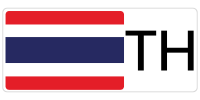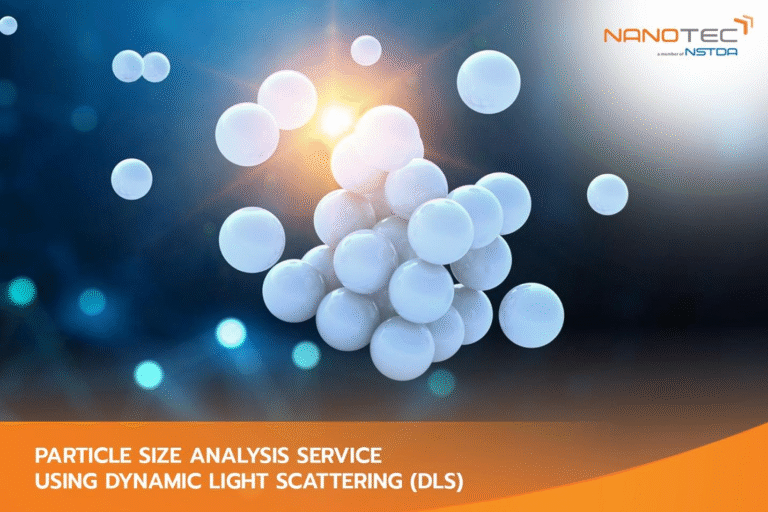Meta description (140–160): Quantify particle size and surface charge in liquid dispersions with NANOTEC’s DLS service—0.3 nm to 10 μm—backed by ISO/IEC 17025 accreditation for sizing in the 50–1,000 nm range.
SEO Keywords: DLS, dynamic light scattering, dls thailand, particle size analysis dispersion, hydrodynamic diameter pdi, zeta potential measurement, iso iec 17025 particle sizing 50–1000 nm, colloid stability testing, nanoemulsion size testing, cosmetics nanoparticle analysis, food and pharma dispersions, materials characterization thailand
Why DLS Matters
If your product contains dispersed particles—nanoemulsions, pigments, fillers, actives, liposomes, or polymer beads—size and surface charge largely determine stability, appearance, efficacy, and shelf life. A serum that separates, an ink that clogs, or a nutraceutical that settles often signals a size or charge problem. Dynamic Light Scattering (DLS) provides a fast, non-destructive way to quantify hydrodynamic diameter and polydispersity, while zeta potential indicates the electrostatic forces that drive aggregation or stability. Together, these metrics help teams optimize formulations, compare supplier lots, and set specifications that stand up to QA and customer review.
What DLS Measures and When to Use It
DLS analyzes the Brownian motion of particles suspended in a liquid and converts the time-dependent light-scattering signal into a hydrodynamic size distribution. It’s particularly powerful for nanoscale and submicron systems where quick, repeatable measurements guide iterative R&D.
- Measurement window (in dispersion): ~0.3 nm to 10 μm
- Primary outputs: Hydrodynamic diameter (e.g., Z-average/mean), PDI (polydispersity index), intensity/number distributions (as applicable)
- Surface charge: Zeta potential to assess colloidal stability in the chosen medium
- Accreditation: ISO/IEC 17025 accredited 50–1,000 nm sizing range
Use DLS to:
- Track formulation stability across pH, ionic strength, temperature, or preservative changes
- Identify aggregation or growth after stress testing or aging
- Compare raw material lots and set acceptance limits for incoming QC
- Optimize surfactant systems in emulsions or dispersions to reduce flocculation and creaming
For multi-modal or very broad populations, you can complement DLS with image- or diffraction-based methods to verify outlying fractions; for the liquid-state behavior that end users experience, DLS remains the go-to.
Accredited Range & Reporting You Can Trust
For projects where specifications and audits matter, our DLS service includes ISO/IEC 17025 accreditation for particle sizing in the 50–1,000 nm range. This means the measurement workflow—instrument setup, calibration, verification, and analysis routines—has been validated for that window.
Your report can include:
- Size metrics (e.g., Z-average/mean), PDI, and distribution plots
- Zeta potential (if requested), with the sign and magnitude relevant to stability
- Key conditions: dispersant, temperature, equilibration time, measurement cell, dilution steps
- Notes for interpretation: observations on scattering quality, repeatability, and any anomalies
Typical Deliverables
Most clients ask for a concise, decision-ready package:
- DLS results: hydrodynamic size(s), PDI, distribution visualizations
- Zeta potential: value and sign, plus an interpretation note for stability expectations
- Method summary: sample prep, cuvette/cell, measurement temperature, repeats
- Comparison tables (optional): side-by-side lots, pre/post-stress results, or formulation variants
Sample Guidance (How to Get Reliable Results)
Good measurements start with good samples. While we’ll tailor preparation to your matrix, the following principles help:
- Representativeness: submit samples that reflect the final dispersion (or provide the formulation steps for us to reproduce).
- Cleanliness: avoid bubbles and particulates not part of the formulation; use clean vials and filtered media where relevant.
- Dispersant & conditions: specify the buffer/solvent, pH, ionic strength, and additives used so we can match real-world behavior.
- Concentration: DLS needs sufficient scattering but not multiple scattering—share the typical range, and we’ll advise on dilution if needed.
- Temperature sensitivity: indicate if the system gels or separates at specific temperatures to set the right measurement window.
Who This Service Is For
Cosmetics & Personal Care (brands, OEM/ODM).
Validate nanoemulsions, liposomes, and pigment dispersions. Use DLS size and zeta potential to tune stability, sensorial performance, and shelf life—and to set supplier/lot acceptance limits with confidence.
Food, Nutraceuticals & Beverages.
Assess colloidal stability and particle size for fortified drinks, emulsions, and functional ingredients. Zeta potential helps anticipate aggregation under pH or ionic changes.
Pharma, Biotech & Medical Materials.
Screen nanosystems, carriers, or particulate excipients rapidly. Use PDI and size to judge uniformity before moving to higher-order studies.
Advanced Materials & Inks/Coatings.
For fillers, polymer dispersions, and functional inks, DLS helps diagnose settling or clogging issues and supports changes to dispersants or processing conditions.
Pricing Overview
Use the guide price to scope your work; we’ll finalize a quote based on sample count, repeats, and whether zeta potential is included.
- DLS particle size analysis (dispersion): from THB 500 per item
- Add-on: Zeta potential measurement for surface charge/stability assessment
- Options: replicate runs, pre/post-stress comparisons, batch comparison tables, and report customization
Frequently Asked Questions (recap)
What size range can you measure?
Approximately 0.3 nm to 10 μm in dispersion; ISO/IEC 17025 accredited sizing applies to 50–1,000 nm.
What does PDI tell me?
PDI indicates distribution breadth; lower values suggest a narrower, more uniform population.
Why measure zeta potential?
Zeta potential reflects surface charge in the measurement medium; larger magnitude (positive or negative) generally correlates with better colloidal stability.
Can you test my actual formulation media?
Yes—measuring in your real buffer/solvent/pH/ionic strength often yields the most meaningful results.
What if I suspect large aggregates?
DLS is sensitive to larger scatterers. We can adjust protocols and, if needed, recommend complementary methods to confirm coarse fractions.
Suggested Internal Links (provisional; finalize later)
- Testing & Analysis Hub
- E-SEM — Morphology & Image-Based Sizing
- AFM — Nanoscale Surface Topography
- Chemical Analysis — FTIR / Raman (for composition context)
- Safety & Toxicology (where relevant to end-use)
Contact Us
Book a DLS session or request a quote for particle size analysis with optional zeta potential. We’ll help you design a fit-for-purpose measurement plan and deliver clear, decision-ready data.Infrastructure Services
National Nanotechnology Center (NANOTEC)
143 INC 2 (B), Thailand Science Park, Phahonyothin Road, Khlong Nueng, Khlong Luang, Pathum Thani 12120
Tel. +66 2 564 7100 ext. 6517, 6625, 6680
Email: bdis-infs@nanotec.or.th


